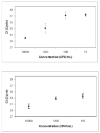Microfluidic platform versus conventional real-time polymerase chain reaction for the detection of Mycoplasma pneumoniae in respiratory specimens
- PMID: 20227222
- PMCID: PMC2854258
- DOI: 10.1016/j.diagmicrobio.2009.12.020
Microfluidic platform versus conventional real-time polymerase chain reaction for the detection of Mycoplasma pneumoniae in respiratory specimens
Abstract
Rapid, accurate diagnosis of community-acquired pneumonia (CAP) due to Mycoplasma pneumoniae is compromised by low sensitivity of culture and serology. Polymerase chain reaction (PCR) has emerged as a sensitive method to detect M. pneumoniae DNA in clinical specimens. However, conventional real-time PCR is not cost-effective for routine or outpatient implementation. Here, we evaluate a novel microfluidic real-time PCR platform (Advanced Liquid Logic, Research Triangle Park, NC) that is rapid, portable, and fully automated. We enrolled patients with CAP and extracted DNA from nasopharyngeal wash (NPW) specimens using a biotinylated capture probe and streptavidin-coupled magnetic beads. Each extract was tested for M. pneumoniae-specific DNA by real-time PCR on both conventional and microfluidic platforms using Taqman probe and primers. Three of 59 (5.0%) NPWs were positive, and agreement between the methods was 98%. The microfluidic platform was equally sensitive but 3 times faster and offers an inexpensive and convenient diagnostic test for microbial DNA.
(c) 2010 Elsevier Inc. All rights reserved.
Figures


Similar articles
-
Detection of Mycoplasma pneumoniae and Chlamydophila pneumoniae directly from respiratory clinical specimens using a rapid real-time polymerase chain reaction assay.Diagn Microbiol Infect Dis. 2012 Jul;73(3):278-80. doi: 10.1016/j.diagmicrobio.2012.03.024. Epub 2012 Apr 25. Diagn Microbiol Infect Dis. 2012. PMID: 22541789
-
Establishment of a microfluidic and RPA-based platform for rapid multi-sample detection of Mycoplasma pneumoniae.Diagn Microbiol Infect Dis. 2025 Aug;112(4):116840. doi: 10.1016/j.diagmicrobio.2025.116840. Epub 2025 Apr 10. Diagn Microbiol Infect Dis. 2025. PMID: 40228365
-
Detection of Mycoplasma pneumoniae in adult community-acquired pneumonia by PCR and serology.J Med Microbiol. 2008 Dec;57(Pt 12):1491-1495. doi: 10.1099/jmm.0.2008/003814-0. J Med Microbiol. 2008. PMID: 19018018
-
Evaluation of different nucleic acid amplification techniques for the detection of M. pneumoniae, C. pneumoniae and Legionella spp. in respiratory specimens from patients with community-acquired pneumonia.J Microbiol Methods. 2008 Jun;73(3):257-62. doi: 10.1016/j.mimet.2008.02.010. Epub 2008 Mar 10. J Microbiol Methods. 2008. PMID: 18378345
-
Laboratory diagnosis of Mycoplasma pneumoniae infection.Clin Microbiol Infect. 2003 Apr;9(4):263-73. doi: 10.1046/j.1469-0691.2003.00590.x. Clin Microbiol Infect. 2003. PMID: 12667235 Review.
Cited by
-
Nucleic acid amplification tests in digital microfluidics: the promise of next-generation point-of-care diagnostics.Microsyst Nanoeng. 2025 Aug 18;11(1):155. doi: 10.1038/s41378-025-00977-5. Microsyst Nanoeng. 2025. PMID: 40825819 Free PMC article. Review.
-
A Routing-Based Repair Method for Digital Microfluidic Biochips Based on an Improved Dijkstra and Improved Particle Swarm Optimization Algorithm.Micromachines (Basel). 2020 Nov 28;11(12):1052. doi: 10.3390/mi11121052. Micromachines (Basel). 2020. PMID: 33260565 Free PMC article.
-
Toward molecular parasitologic diagnosis: enhanced diagnostic sensitivity for filarial infections in mobile populations.J Clin Microbiol. 2011 Jan;49(1):42-7. doi: 10.1128/JCM.01697-10. Epub 2010 Oct 27. J Clin Microbiol. 2011. PMID: 20980560 Free PMC article.
-
Digital microfluidics comes of age: high-throughput screening to bedside diagnostic testing for genetic disorders in newborns.Expert Rev Mol Diagn. 2018 Aug;18(8):701-712. doi: 10.1080/14737159.2018.1495076. Epub 2018 Jul 13. Expert Rev Mol Diagn. 2018. PMID: 30004274 Free PMC article.
-
Rapid molecular assays for specific detection and quantitation of Loa loa microfilaremia.PLoS Negl Trop Dis. 2011 Aug;5(8):e1299. doi: 10.1371/journal.pntd.0001299. Epub 2011 Aug 30. PLoS Negl Trop Dis. 2011. PMID: 21912716 Free PMC article.
References
-
- Auroux PA, Koc Y, deMello A, Manz A, Day PJ. Miniaturised nucleic acid analysis. Lab Chip. 2004;4:534–546. - PubMed
-
- Beersma MFC, Dirven K, van Dam AP, Templeton KE, Claas ECJ, Goossens H. Evaluation of 12 commercial tests and the complement fixation test for Mycoplasma pneumoniae-specific immunoglobulin G (IgG) and IgM antibodies, with PCR used as the “gold standard”. J Clin Microbiol. 2005;43:2277–2285. - PMC - PubMed
-
- Chen L, Manz A, Day PJ. Total nucleic acid analysis integrated on microfluidic devices. Lab Chip. 2007;7:1413–1423. - PubMed
-
- Cler L, Bu D, Lewis C, Euhus D. A comparison of five methods for extracting DNA from paucicellular clinical samples. Mol Cell Probes. 2006;20:191–196. - PubMed
Publication types
MeSH terms
Grants and funding
LinkOut - more resources
Full Text Sources
Other Literature Sources
Miscellaneous

